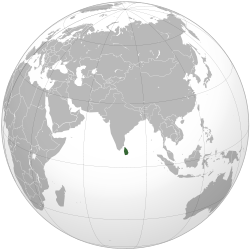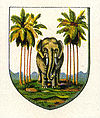- British Ceylon
-
British Ceylon British colony ← 
1815–1948  →
→Flag
Anthem
God Save The KingCapital Colombo Language(s) Sinhala, Tamil, & English Government Constitutional Monarchy Monarch of Ceylon - 1815-1820 George III - 1820-1830 George IV - 1830-1837 William IV - 1837-1901 Victoria - 1901-1910 Edward VII - 1910-1936 George V Governor of Ceylon - 1798-1805 Frederick North - 1805-1811 Thomas Maitland - 1812-1820 Robert Brownrigg - 1944-1948 Henry Monck-Mason Moore Prime minister - 1947-1948 Don Stephen Senanayake Legislature Legislative Council of Ceylon
State Council of CeylonHistorical era New Imperialism - Kandyan Convention March 5, 1815 - Independence February 4, 1948 Currency Ceylonese rixdollar (1815 - 1828)
British pound (1825 - ?)British Ceylon refers to British rule prior to 1948 of the island territory now known as Sri Lanka.
Contents
History
From the Dutch to the British
Main article: Dutch CeylonBefore the beginning of the Dutch governance, the island of Ceylon was divided between the Portuguese Empire and the Kingdom of Kandy, who were in the midst of a war for control of the island as a whole. The island attracted the attention of the newly formed Batavian Republic when they were invited by the Sinhalese king to fight the Portuguese, and Dutch rule was soon imposed.
The Dutch, weakened by their wars against Great Britain, were eventually conquered by Napoleon and their leaders became refugees in London. No longer able to effectively govern the island the Dutch transferred the rule of Ceylon to the British against the will of the Dutch residing there.
Kandyan Wars
Main article: Kandian WarsAs soon as Britain gained Ceylon from the Dutch they wanted to expand it by making the native Kingdom of Kandy a protectorate, an offer refused by the King of Kandy. Though the previous administration had not been powerful enough to threaten the reign of the Kandyan Kings, the British Empire was much more powerful. The refusal to become a protectorate lead to outright war between the two factions, which ended with the capitulation of the Kandyans in 1815.
Kandyan Convention
Main article: Kandyan ConventionThe rule of the king Sri Vikrama Rajasinha was not favored by his chieftains. The king who was of South Indian ancestry faced powerful chieftains and sought cruel measures to repress their popularity with the people. A successful coup was organized by the Sinhala chiefs in which they accepted the British crown as their new king. This ended the line of the kingdom of Kandy and King Rajasinhe was taken as a prisoner. thought that the English will hand over the power to him.
But the English annexed Ceylon with Madras Presidency for economical and strategical reasons. The Kandyan treaty which was signed at the annexation of Kandy was called Kandyan Convention and consists of the terms under which the Kandyans will live under British rule.
The Buddhist religion was to be given protection by the Crown and Christianity would not be imposed on the unwilling masses as it happened during Portuguese and Dutch rule. It spelt the end of a most cruel tyrant who tortured Sinhala aristocracy at will in one of the most cruel ways. Kandyan Convention is an important legal document because it specifies the conditions which the British promised to rule the Kandyan territory.
Soon the Kandyans rebelled against the English and waged a guerilla war. It was called the Uva Rebellion and the British carried out the massacre of the 19th Century by wiping out the all able bodied Sinhalese men from the Hill country. Main causes of the rebellion seems to be the loss of power of the Kandyan chieftains.
The Uva Rebellion
Main article: Uva RebellionIt took the ruling families of Kandy less than two years to realise that the authority of the British government was a fundamentally different beast to that of the (deposed) Nayakkar dynasty. Discontent with British activities soon boiled over into open rebellion, commencing in the duchy of Uva in 1817. Generally called the 'Uva Rebellion', it is also known as the Third Kandyan War. In many ways the third name is more appropriate, as the rebellion (which soon developed into a guerilla war of the kind the Kandyans had fought against European powers for some time) was centred on the Kandyan nobility and their unhappiness with developments under British rule since 1815. However it is the last uprising of this kind and Britain's response essentially liquidated the old aristocracy and ensured future rebellions would take on a much more subaltern character.
The British Raj and the support of the Natives
Main article: Burgher PeopleThe multiracial of Ceylon was numerous enough to support the European colonists and the Portuguese and the Dutch offspring of the past 300 years of colonial history was enough to run a stable government. Unlike the previous rulers the British embarked on a plantation programme which brought coffee plantation which was later wiped out by coffee rust. Coffee plants were replaced by tea and rubber plantations. This made Ceylon one of the richest countries in Asia.
The British also brought a million Tamils from British India and made them indentured laborers in the Hill country. This was in addition to the several hundred thousand Tamils already living in the Maritime provinces and another 30,000 Mappilla Muslims whose mother tongue is Tamil. Thus the seed of ethnic discord was sown in the British Era. The linguistically bipolar island needed a link language and English became universal in Ceylon.
The laying of the railway, the opening of coffee and tea plantations, road development schemes, establishment of hospitals and maternity homes throughout the island, were some of the major works undertaken by the British who ruled Sri Lanka.
British Governors of Ceylon (1796–1948)
Main article: British governors of CeylonBetween 1796 and 1948, Ceylon was a British crown colony. Although the British monarch was the head of state, in practice his or her functions were exercised in the colony by the colonial Governor, who acted on instructions from the British government in London.
See also
References
External links
Sri Lanka topics History TimelinePrehistory · Dipavamsa · Mahavamsa · Culavamsa · Vijaya · Portuguese Ceylon · Dutch Ceylon · British Ceylon · Kandyan Wars · Uva Rebellion · Matale Rebellion · Independence movement · Dominion of Ceylon · Civil WarkingdomsKingdom of Tambapanni · Kingdom of Upatissa Nuwara · Anuradhapura Kingdom · Kingdom of Polonnaruwa (Kingdom of Jaffna · Kingdom of Ruhuna) · Kingdom of Dambadeniya · Kingdom of Gampola · Kingdom of Raigama · Kingdom of Kotte · Kingdom of Sitawaka · Kingdom of KandyTopicsGovernment Politics Elections · Parliament · President of Sri Lanka (current) · Prime Minister (current) · Foreign relations · Elections · Political parties · Supreme Court · PoliceGeography LandformsExtreme points · Mountains · Islands · Rivers · Waterfalls
EnvironmentEconomy Central Bank of Sri Lanka · Sri Lankan rupee · Colombo Stock Exchange · Agriculture · Ceylon tea · Gems · Communications · Power stations · Companies · Banking · Insurance · Standard of living · Tourism · Buildings · Transportation (Airports · A-Grade Highways · Passenger vehicles · Railroads)Society Crime · Demographics (Ethnic groups in Sri Lanka) · Education (schools · universities) · Health care · Languages (Sri Lankan English) · Media · People (List of Sri Lankans) · Public holidays · Religion (Buddhism · Hinduism · Islam) · Social class · Sports (Cricket · Rugby) · BirthCulture Architecture (Ancient architecture / constructions (stupas)) · Television / Cinema · Cuisine · Dance · Folklore · Fashion · Literature · Music · Scouting · World Heritage Sites · Poetry · Radio · Visual artsSymbols Other topics Human rights · ResearchCategories:- Former monarchies of Asia
- Former countries in South Asia
- Former British colonies
- States and territories established in 1815
- States and territories disestablished in 1948
- 1948 disestablishments
- History of Sri Lanka
- British rule in Ceylon
- 19th century in Sri Lanka
- 20th century in Sri Lanka
Wikimedia Foundation. 2010.



